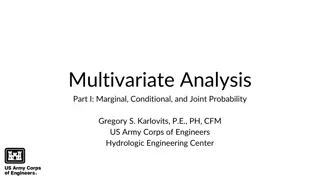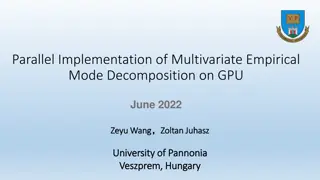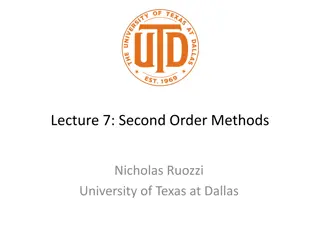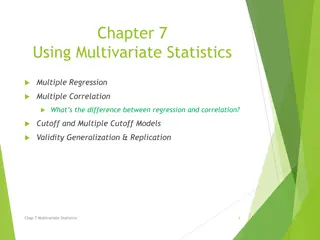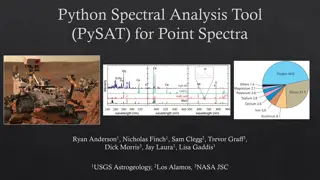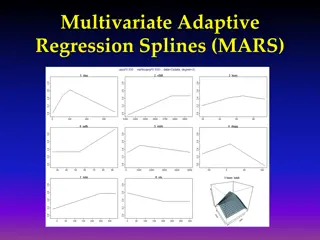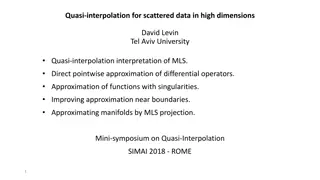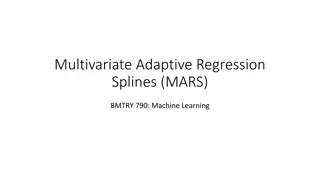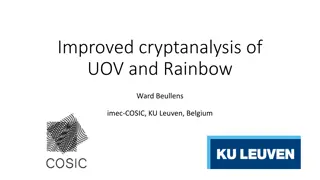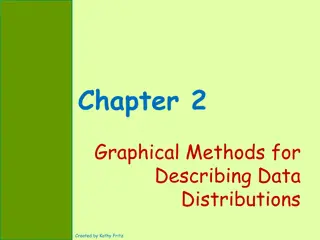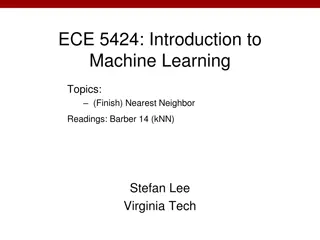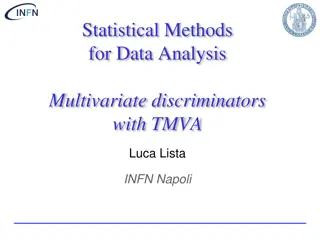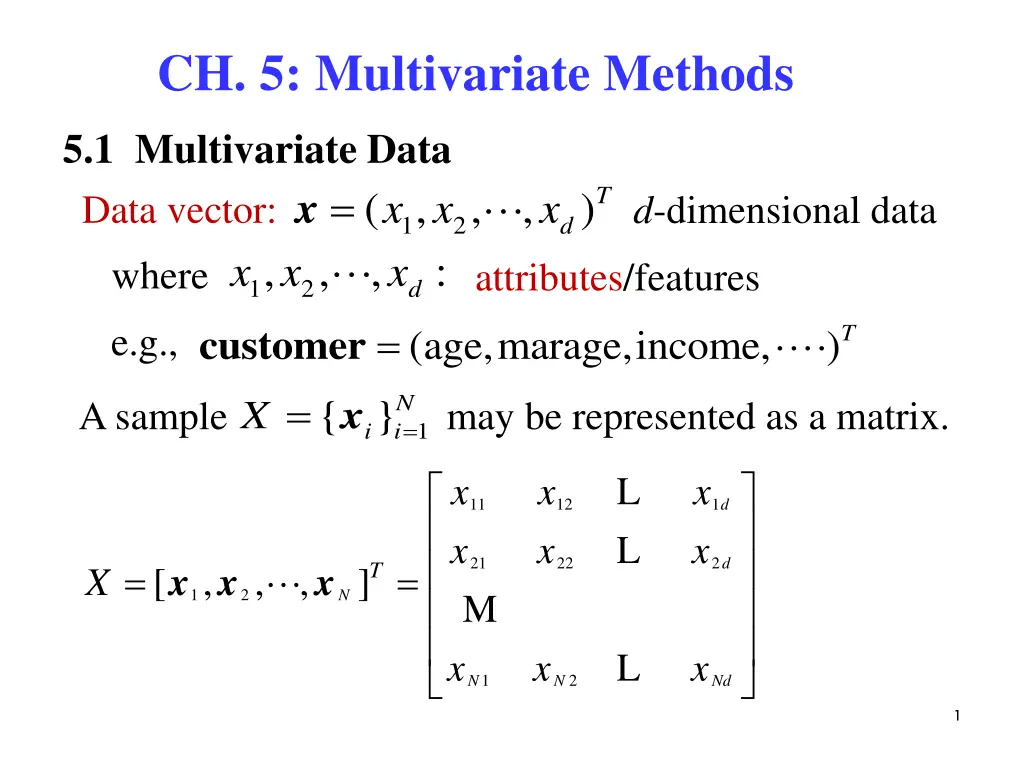
Understanding Multivariate Methods for Data Analysis
Explore multivariate analysis techniques including data vectors, parameter estimation, missing value estimation, multivariate normal distribution, and more. Learn about sample mean, covariance matrix, Mahalanobis distance, and methods for handling missing values in multivariate data. Dive into the world of multivariate methods for comprehensive data analysis.
Download Presentation

Please find below an Image/Link to download the presentation.
The content on the website is provided AS IS for your information and personal use only. It may not be sold, licensed, or shared on other websites without obtaining consent from the author. If you encounter any issues during the download, it is possible that the publisher has removed the file from their server.
You are allowed to download the files provided on this website for personal or commercial use, subject to the condition that they are used lawfully. All files are the property of their respective owners.
The content on the website is provided AS IS for your information and personal use only. It may not be sold, licensed, or shared on other websites without obtaining consent from the author.
E N D
Presentation Transcript
CH. 5: Multivariate Methods 5.1 Multivariate Data Data vector: x x where = )T x ( , x x , d x = , , x d-dimensional data 1 2 d , , : attributes/features 1 2 e.g., )T customer (age,marage,income, A sample may be represented as a matrix. 1 { }N i i X = = x L L x x x x x x 11 12 1 d 21 M 22 2 d = , , = T x x x [ , ] X 1 2 N L x x x 1 2 N N Nd 1
5.2 Parameter Estimation x T = = Mean vector: 1, , , E d = E x N = where p x i i ij ij = 1 j Covariance matrix: [( E x covariance of 2 1 L L 12 2 2 1 d ( )( ) T = = 21 M 2 d x x E 2 d L where 1 2 d d = = = = 2 i 2 ix Var( ) Cov( , [( = ) ] : x E x ) j variance of i i i )( )] x x x ij i i i j j and x x [ ] : E x x i j i j i j 2
Correlation coefficient: ( ) Cov , x x ( ) i j ij = = = Corr , x x ij i j Var( ) Var( i x ) x i j j Parameter Estimation { }N i i = x ( m m = X Given a sample = = N 1 , , x ij = 1 j m Sample mean: , ), m m 1 2 d i N Sample covariance matrix: )( ) = ( N x m N [ ], ij r x m ik i jk j = = 1 [ ], where ij s k S s ij s = = ij R r Sample correlation matrix: ij s s i j 3
5.3 Estimation of Missing Values Certain instances have missing attributes. Ignore those instances: not a good idea if the sample is small. Imputation: Fill in the missing value Mean imputation: Substitute the mean of the available data of the missing attribute Imputation by regression: Predict based on other attributes 4
5.4 Multivariate Normal Distribution ( ) = T x Suppose data vector ( , x x , , ) ~ , x N 1 2 d 1 d 1 2 ( ) x ( ) ( ) T = 1 x x i.e., exp p ( ) /2 1/2 ) 2 ( ( ) T 1 where x x : Mahalanobis distance measures the distance from x to in terms of , which normalizes variances of different dimensions 5
e.g., ( ) 2 x 1 ( ) p x = exp d = 1, ( ) 1/2 2 2 2 ( ) 2 2 x the square distance from x to in unit. x ( ) ( ) = = 2 1 ( ) : x x 2 2 1 2 1 = = 12 2 2 1 2 d = 2, 2 2 12 1 2 2 1 = = = 2 1 2 2 2 2 1 2 2 2 2 1 2 2 1 2 (1 ) 2 2 1 2 6
2 2 2 2 1 2 1 2 1 2 1 2 2 2 = = 1 1 2 1 2 2 2 1 (1 ) 1 2 1 1 1 2 = 2 1 1 2 2 1 2 1 2 1 1 ( ) ( ) ( ) ( ) T T 1 2 1 x x x x = 2 1 1 2 2 1 2 7
1 2 1 x x 1 1 2 1 1 = ( ) x x 1 1 2 2 2 1 1 2 2 2 2 1 2 2 2 1 x x x x = + 2 1 1 1 1 2 2 2 2 2 1 1 1 2 2 x (z- normalization) = = , 1,2 z i i i Let i i 1 ( ) ( ) ( ) T = + 1 2 1 2 2 x x 2 z 1 2 z z z 2 1 + = 2 1 2 2 2 2 . z 1 2 z z z c Consider 8
the above equation expresses an ellipse. For 1, the major axis of the ellipse has a positive (negative) slope. 0 ( 0), When 9
( ) ( ) T . 1 : hyperellipsoid centered at = 1 2 x x c Both its shape and orientation are governed by , which normalizes all variables to their unit standard deviations. ( ) ~ , , . x w N R [ ] [ ] E E = = w x w x w Q ( ) d T T T w x . w w w ~ , N Let ( T T T = 2 T T T w x w x w x w Var( = = ) [( w x [ ]) ] x w E E = 2 T T T T w x x w w [( ) ] [( w ( )( ) ] E w E = T T T x [( )( ) ] ) E i.e., The projection of a d-D normal on a vector w is univariate (i.e., 1-D) normal. 11
W be a matrix. d k Let ( ) T T T x Then ~ , : variate normal W N W W W k 5.5 Multivariate Classification i C From the Bayes rule, the posterior probability of ( | ) ( ( | ) ( ) p x Define discriminant function of ( ) ( ) log | log i i g p C = + x x x ) p C p C 1, , = = i K x , P C i i i i C ( ) . P C i Assume ( | p x 1 1 2 ) ( ) ( ) T = 1 x x exp C ( ) i i i i /2 1/2 d 2 i 12
1 2 ---- (A) 1 2 d ( ) ( ) ( ) x T = 1 x x log2 log g i i i i i 2 log ( ) + P C i { , } , = x r t t N t Given a sample X where = 1 x 1 0 C = = = i x r { , x , }, { , r , }, x r r 1 1 d K i otherwise ( ), , P C Estimation of Parameters i i i ( )( t i r ) = T t t t x m x m t t t x r r r ( ) i i i i i = = m t , , P C S t t i i i t N r i t t d log2 Substituting into (A) and ignore 2 13
1 2 1 2 log 1 2 1 2 ( ( ) ( ) ( ) ( ) x T = + 1 x m x m log log g S S P C i i i i i i ) = + 1 1 1 T T T x x x m m m log 2 S S S S i i i i i i i ( ) + ----- (B) P C i ( ) x = + + T T x x w x i g W w i) Quadratic discriminant: 0 i i i 1 2 1 2 = = 1 1 w m where , W S S i i i i 1 2 i ( ) = + 1 T m m log log w S S P C 0 i i i i i i The number of parameters to be estimated is for means and for covariance matrices S K d 1)/2 , . K = m Kd d + , i = ( , , , ) m m m ( 1 2 i d = [ ] 1, mn d d s i 14
= Share common sample covariance, and 1log S 1 x x m x i i g S = i.e., , i S S i ignore . (B) reduces to 2 ( ) ( 2 ) ( ) ( ) T + 1 m log P C i i 1 2 ( ) ( ) P C = + 1 1 1 T T T x x x m m m 2 +log -- (C) S S S i i i i K d The numbers of parameters to be estimated: for means and for covariance matrices. ( 1)/2 d d + TS Ignoring quadratic term , (C) reduces to 1 2 1 x x ( ) ( ) x = + 1 1 T T x m m m log ---- (D) g S S P C i i i i i 15
( ) x = + T w x g w ii) Linear discriminant: 0 i i i 1 2 ( ) = = + 1 1 T w m m m where , log S w S P C 0 i i i i i i Assuming off-diagonals of S to be 0, 1/ 2 1 0 2 1 0 s 0 0 0 s s 2 2 2 2 0 1/ s = = 1 and S S 0 s 0 2 d 2 d 0 0 0 0 1/ s 1 2 ( ) ( ) T S Substitute into 1 x m x m i i 16
1/ 2 1 0 0 s 2 2 0 1/ s 1( 2 = , , , ) g x m x m x m 1 1 2 2 i i d di 0 2 d 0 0 1/ s x x m m 1 1 i 2 x m d 1 2 2 2 i j ij = g s = 1 j j x m d di Substitute this into (C) 17
iii) Naive Bayes classifier: 2 x m d 1 2 ( ) ( ) x j ij = + log ---- (E) g P C i i s = 1 j j The number of parameters to be estimated is for means and d for covariance matrices. K d = Assuming all variances to be equal, i.e., j s s j d 1 s ( ) 2 ( ) ( ) x = + t j (E) log g x m P C i ij i 2 2 = 1 j K d The number of parameters to be estimated is for means and 1 for . 2s 18
( ) Assuming equal priors and ignore s, ( 1 j = iv) Nearest mean classifier: ( ) ( 2 xx m x+ m m i = P C i d ) 2 ( ) x 2 = = t j x m g x m i ij i 2 = = T x x m x m x m ( ) ( ) g i i i i T T T ) i i xxT m x = Ignore the common term 1 2 1 2 ( ) x 2 = T T T m x i m m i m g i i i i mi Assuming equal , ( ) x = T m x g v) Inner product classifier: i i 19
5.6 Tuning Complexity As we increase complexity, bias decreases but variance increases (bias-variance dilemma). 20
5.7 Discrete Attributes = ( , , , ), x x x x Binary features: 1 2 d jx where are binary. {0, 1} ( ) ( ) ( ) ( ) 1 x x ij = = = j | 1 Let 1 | . p x C p p p p x C j j i ij ij j i If xj s are independent, ( ) d d ( ) ( ) ( ) 1 x x ij = = x j | | 1 p C p x C p p j i j i ij = = 1 1 j j The discriminant function: ( ) ( ) P C ( ) x = + x log | log g p C i i i ( ) ( ) ( ) P C = + + log 1 log 1 log x p x p j ij j ij i j 21
= ( , , , ), x x x x Multinomial features: 1 2 d = 1 0 if otherwise x v { , , , v v } x v = j k z 1 2 j n Define j jk Let : the probability that takes value , ijk p ( 1| ijk jk i p p z C p x = = = x C kv j i ) ( ) = | v C i.e., j k i n d d ( ) j ( ) z ijk = = x | | p C p x C p If xj s are independent, jk i j i = = = 1 1 1 j j k The discriminant function: ( ) log i g p x x n d j ( ) ( ) P C ( ) P C z ijk = + = + | log log log C p jk i i i = = 1 1 j k ( ) P C = + log log z p jk ijk i j k 22
5.8 Multivariate Regression Linear multivariate model ( ) = + t t x | , ,..., r f w w w 0 1 d + = + + + + t t t d L w w x w x w x 0 1 1 2 2 d 2 ~ (0, ) Assume N Then, maximizing the likelihood minimizing the sum of squared error 2 N 1 2 ( ) = t t t d , ,..., | L E w w w X r w w x w x 0 1 0 1 1 d d = 1 w w t , ,..., w Taking derivatives wrt , respectively, 0 1 d 23
= + + + + t t t t d r Nw w x w x w x 0 1 1 2 2 d t t t t = + + + + 2 t t t t t t t t d ( ) x x r w x w w x x w x x 1 0 1 1 1 2 1 2 1 d t t t t t = + + + + 2 t d t t d t d t t t t d ( ) x r w x w x x w x x w x 0 1 1 2 1 2 d t t t t t = T T r w In vector-matrix form: , where X = ( ) X X = w X X 1 1 2 1 1 d 1 1 x x x = w w 1 r r 0 2 1, X , X = = w r . N N d 1 x x w N r 1 d + 1 T T r r X Solution: 24
Generalizing the linear model: i) A polynomial model can lead to a linear multivariate , x x = = = 2 k , , x x x x model by letting 1 2 k Example: Find a quadratic model of two variables and , i.e., x w w x + x 1 2 = + + + + 2 2 ( , ) f x x w x 3 1 2 w x x w x w x 1 2 0 1 1 2 2 4 1 5 2 to fit a sample = = t t t N t x ( ( , x x ), ) , r X = 1 2 1 i.e., determine iw i = , 1, ,5. Answer: Write the fit as = + + + + + ( , ) f x x w w z w z w z w z w z 1 2 0 1 1 2 2 3 3 4 4 5 5 25
= = = = = 2 1 2 2 , , , , z x z x z 1 2 x x z x z x where 1 1 2 2 3 4 5 i w i = , 1, ,5. Use linear regression to learn = = 2 ii) Let sin , exp , x x x x 1 2 A nonlinear model can lead to a linear multivariate model. 26
Summary Multivariate methods -- deal with multivariate data. = )T x , ( , x x , d x , , x Multivariate data: where 1 2 d , : x x attributes/features 1 2 Multivariate parameters of interest: x T = = Mean vector: 1, , , E d = E x N = where p x i i ij ij = 1 j 27
Covariance matrix: 2 1 L L 12 2 2 1 d ( )( ) T = = 21 M 2 d x x E 2 d L 1 2 d d = = where 2 i 2 Var( ) [( ) ] : x E x i i i = = = Cov( , ) [( )( )] x x E x x ij i j i i j j [ ] : E x x i j i j ij = Correlation matrix: , were ij ij i j 28
Imputation: estimating missing values Mean imputation: Substitute the mean of the available data of the missing attribute Imputation by regression: Predict based on other attributes Multivariate Normal Distribution 1 1 2 ( ) x ( ) ( ) T = 1 x x exp p ( ) /2 1/2 d 2 29
( ) ( ) T Mahalanobis distance 1 x x : measures the distance from x to which normalizes variances of different dimensions. in terms of , ( . ) ( ) T : hyperellipsoid centered at = 1 2 x x c Both its shape and orientation are governed by , which normalizes all variables to their unit 1 standard deviations. ~ x N ( ) ( ) d w , , . R T T T w x w w w Let ~ , N i.e., The projection of a d-D normal on a vector w is univariate (i.e., 1-D) normal. 30
W be a matrix. d Let k ( ) T T T x Then ~ , : variate normal W N W W W k Multivariate Classification ( ) x = + + T T x x w x i i) Quadratic discriminant: g W w 0 i i i 1 2 1 2 = = 1 1 w m where , W S S i i i i 1 2 i ( ) = + 1 T m m log log w S S P C 0 i i i i i i ( ) x = + T w x g w ii) Linear discriminant: 0 i i i 1 2 ( ) = = + 1 1 T w m m m where , log S w S P C 0 i i i i i i 31
iii) Naive Bayes classifier: 2 x m d 1 2 ( ) ( ) x j ij = + log ---- (E) g P C i i s = 1 j j iv) Nearest mean classifier: ( ) ( 2 xx = 2 = = T x x m x m x m ( ) ( ) g i i i i T T T m x+ m m i ) i i ( ) x = T m x g v) Inner product classifier: i i 32

